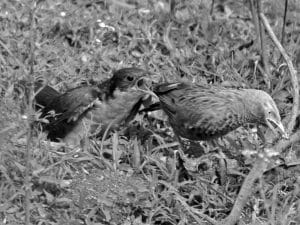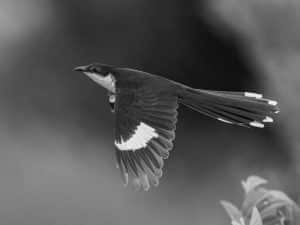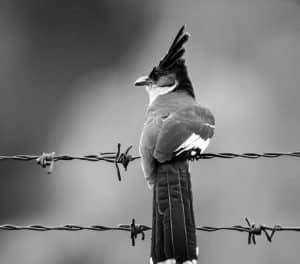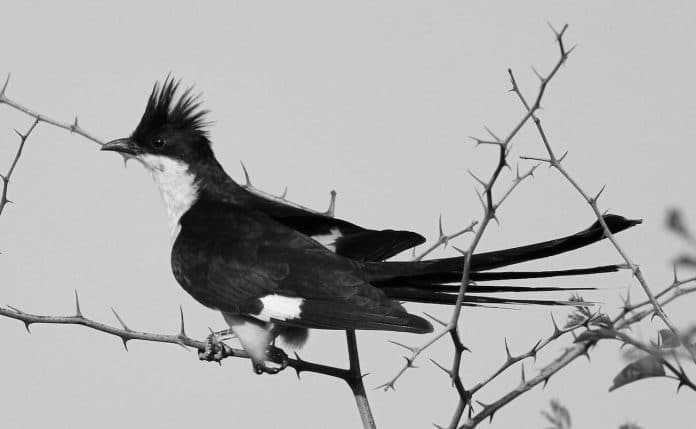Introduction to the pied cuckoo
The pied cuckoo, also known as the Jacobin cuckoo or pied crested cuckoo, is a striking bird species that can be found in Tanzania. With its monochrome plumage and distinctive call, the pied cuckoo is a fascinating creature that captivates birdwatchers and nature enthusiasts alike. In this article, we will explore the habitat, physical characteristics, breeding behavior, migration patterns, and conservation efforts of the pied cuckoo in Tanzania. Join us on this journey as we delve into the world of this remarkable avian species.
Habitat and distribution of the pied cuckoo in Tanzania

The pied cuckoo is a migratory bird that can be found in various habitats across Tanzania. During the breeding season, it is commonly spotted in the woodlands and savannas of the northern regions, such as Serengeti National Park and Arusha National Park. These areas provide the ideal environment for the pied cuckoo, with their abundance of trees and shrubs that offer ample nesting and foraging opportunities.
Outside of the breeding season, the pied cuckoo migrates to different parts of Tanzania, including the coastal regions and the southern highlands. It is known to travel long distances, often crossing international borders to reach its wintering grounds. This wide distribution makes Tanzania a prime location for observing the pied cuckoo in its various habitats throughout the year.
Physical characteristics of the pied cuckoo
The pied cuckoo is a medium-sized bird, measuring around 30 centimeters in length. It has a distinct black and white plumage, with a white breast and underparts contrasting against its black head, back, and wings. The bird’s wingspan is approximately 60 centimeters, enabling it to glide gracefully through the air.
One of the most striking features of the pied cuckoo is its crested head. The black crest extends from the bird’s forehead to the nape of its neck, giving it a regal appearance. Its bill is slender and slightly curved, allowing it to catch insects and other small prey with precision. Overall, the pied cuckoo’s physical characteristics make it a visually stunning bird that stands out against the backdrop of Tanzania’s diverse landscapes.
Breeding behavior and lifecycle of the pied cuckoo
The breeding behavior of the pied cuckoo is truly remarkable. Unlike other bird species, the pied cuckoo does not build its own nest. Instead, it relies on other birds, known as host species, to raise its young. The female pied cuckoo carefully selects a suitable host nest, often choosing species such as the tawny-flanked prinia or the red-billed buffalo weaver.
Once the host nest is chosen, the female pied cuckoo lays a single egg, which mimics the appearance of the host eggs. This allows the cuckoo chick to blend in and avoid detection by the host parents. The young cuckoo hatches earlier than the host eggs, giving it a head start in receiving parental care and food from the unwitting host parents.
As the cuckoo chick grows, it becomes increasingly demanding and aggressive towards the host nestlings. Eventually, the young cuckoo outcompetes and ejects the host young from the nest, ensuring that it receives all the attention and resources from the host parents. This unique breeding strategy, known as brood parasitism, is a fascinating adaptation that has allowed the pied cuckoo to thrive in Tanzania’s ecosystems.
Migration patterns and routes of the pied cuckoo in Tanzania

The pied cuckoo is a migratory bird that undertakes an incredible journey across Africa. It spends the breeding season in Tanzania and other East African countries, before embarking on a long-distance migration to its wintering grounds in southern Africa. The exact migration routes of the pied cuckoo can vary, but it generally follows a southwesterly path, traversing countries such as Zambia, Zimbabwe, and Botswana.
During migration, the pied cuckoo faces numerous challenges, including predation, adverse weather conditions, and the need to find suitable stopover sites for rest and refueling. Despite these obstacles, the pied cuckoo has evolved remarkable navigational abilities, relying on celestial cues, geographical landmarks, and even the Earth’s magnetic field to guide its journey.
The migration of the pied cuckoo is not only a testament to the bird’s physical endurance and adaptability but also highlights the interconnectedness of ecosystems across Africa. By studying the migration patterns of the pied cuckoo, researchers gain valuable insights into the health and conservation of the diverse habitats it relies upon throughout its annual journey.
The significance of the pied cuckoo in Tanzanian ecosystems
The presence of the pied cuckoo in Tanzanian ecosystems has far-reaching implications for biodiversity and ecosystem health. As a brood parasite, the pied cuckoo plays a crucial role in regulating the populations of its host species. By infiltrating host nests and outcompeting the host young, the pied cuckoo helps to control the numbers of potential competitors, thereby promoting the survival and reproductive success of other bird species.
Furthermore, the pied cuckoo’s diet consists mainly of insects, including caterpillars, grasshoppers, and beetles. This makes it an important predator of agricultural pests, helping to reduce crop damage and increase agricultural yields. The presence of the pied cuckoo in Tanzania’s agricultural landscapes can therefore have significant economic benefits for local communities.
Finally, the pied cuckoo serves as an indicator species for the overall health of Tanzania’s ecosystems. Its presence and abundance can provide valuable information about the state of the environment, including the availability of suitable nesting sites, the abundance of insect prey, and the impacts of climate change. Monitoring the population trends of the pied cuckoo can therefore inform conservation efforts and help ensure the long-term sustainability of Tanzania’s natural resources.
Conservation efforts for the pied cuckoo in Tanzania
Recognizing the importance of the pied cuckoo in Tanzanian ecosystems, various conservation organizations and researchers are working together to protect this remarkable bird species. Efforts are focused on raising awareness about the pied cuckoo’s ecological role, conducting research on its breeding behavior and migration patterns, and implementing measures to safeguard its habitat.
Conservation initiatives include the establishment of protected areas and wildlife corridors that connect the pied cuckoo’s breeding, wintering, and stopover sites. These areas not only provide safe havens for the bird but also support the overall biodiversity of Tanzania. Additionally, community-based conservation projects aim to engage local communities in sustainable land management practices and promote the value of the pied cuckoo as an ecotourism attraction.
By combining scientific research, community involvement, and policy advocacy, conservation efforts for the pied cuckoo in Tanzania are making significant strides towards ensuring the long-term survival of this monochrome marvel of nature.
Best locations for birdwatching the pied cuckoo in Tanzania

For birdwatchers and nature enthusiasts, Tanzania offers a wealth of opportunities to observe the pied cuckoo in its natural habitat. The following locations are known to be prime spots for birdwatching and photography:
- Serengeti National Park: This iconic national park is not only famous for its wildebeest migration but also serves as a breeding ground for the pied cuckoo. Visitors can witness the bird’s courtship displays and nesting behavior amidst the stunning backdrop of the Serengeti plains.
- Arusha National Park: Located near the town of Arusha, this national park is a haven for birdwatchers. Its diverse range of habitats, including montane forests and alkaline lakes, provides ample opportunities to spot the pied cuckoo and other avian species.
- Selous Game Reserve: As one of the largest protected areas in Africa, the Selous Game Reserve offers a unique birdwatching experience. The reserve’s riverine forests and wetlands attract a rich diversity of birdlife, including the pied cuckoo.
- Mikumi National Park: Situated in the southern part of Tanzania, Mikumi National Park is home to a variety of bird species, including the pied cuckoo. The park’s open grasslands and acacia woodlands provide excellent viewing opportunities for birdwatchers.
- Ruaha National Park: Known for its rugged landscapes and abundant wildlife, Ruaha National Park is also a birdwatcher’s paradise. The park’s baobab-studded plains and riverine habitats harbor a diverse array of bird species, with the pied cuckoo being a common sight during the breeding season.
Tips for spotting and photographing the pied cuckoo
Spotting and photographing the pied cuckoo in Tanzania can be a rewarding experience. Here are some tips to enhance your chances of success:
- Research the best time of year to visit Tanzania for pied cuckoo sightings. The breeding season, from September to March, is generally the most opportune time to observe these birds.
- Acquaint yourself with the pied cuckoo’s distinct call, as it can help you locate their presence in the vicinity. Online resources and field guides can provide audio recordings for reference.
- Carry binoculars or a spotting scope to get a closer look at the pied cuckoo’s distinctive plumage and behavior. These optical tools will enhance your ability to observe and appreciate the bird’s features.
- Be patient and observant. The pied cuckoo may be well-camouflaged or hidden within foliage, so take your time to scan the surroundings and listen for their calls.
- Practice ethical bird photography by maintaining a respectful distance and using a telephoto lens to capture close-up shots without disturbing the birds. Remember that the welfare of the birds and their habitat should always come first.
By following these tips and immersing yourself in the natural beauty of Tanzania, you will have a greater chance of encountering and documenting the monochrome marvel of the pied cuckoo.
Conclusion: Appreciating the beauty of the pied cuckoo in Tanzania
In conclusion, the pied cuckoo is a monochrome marvel of nature that can be found in Tanzania’s diverse habitats. Its striking appearance, unique breeding behavior, and remarkable migratory journey make it a species of great ecological and conservation significance. By appreciating and protecting the pied cuckoo, we not only contribute to the preservation of Tanzania’s rich biodiversity but also gain a deeper understanding of the interconnectedness of ecosystems across Africa. So, whether you are a birdwatching enthusiast or simply curious about the wonders of nature, make sure to add the pied cuckoo to your list of discoveries in Tanzania.


































